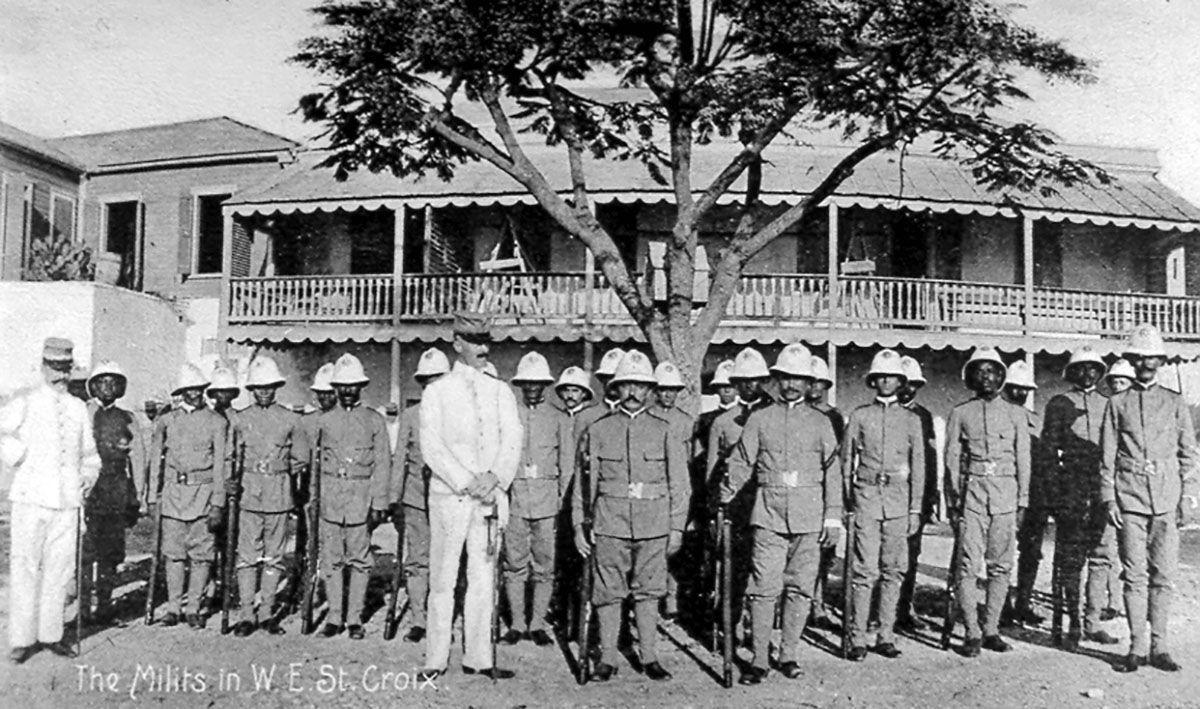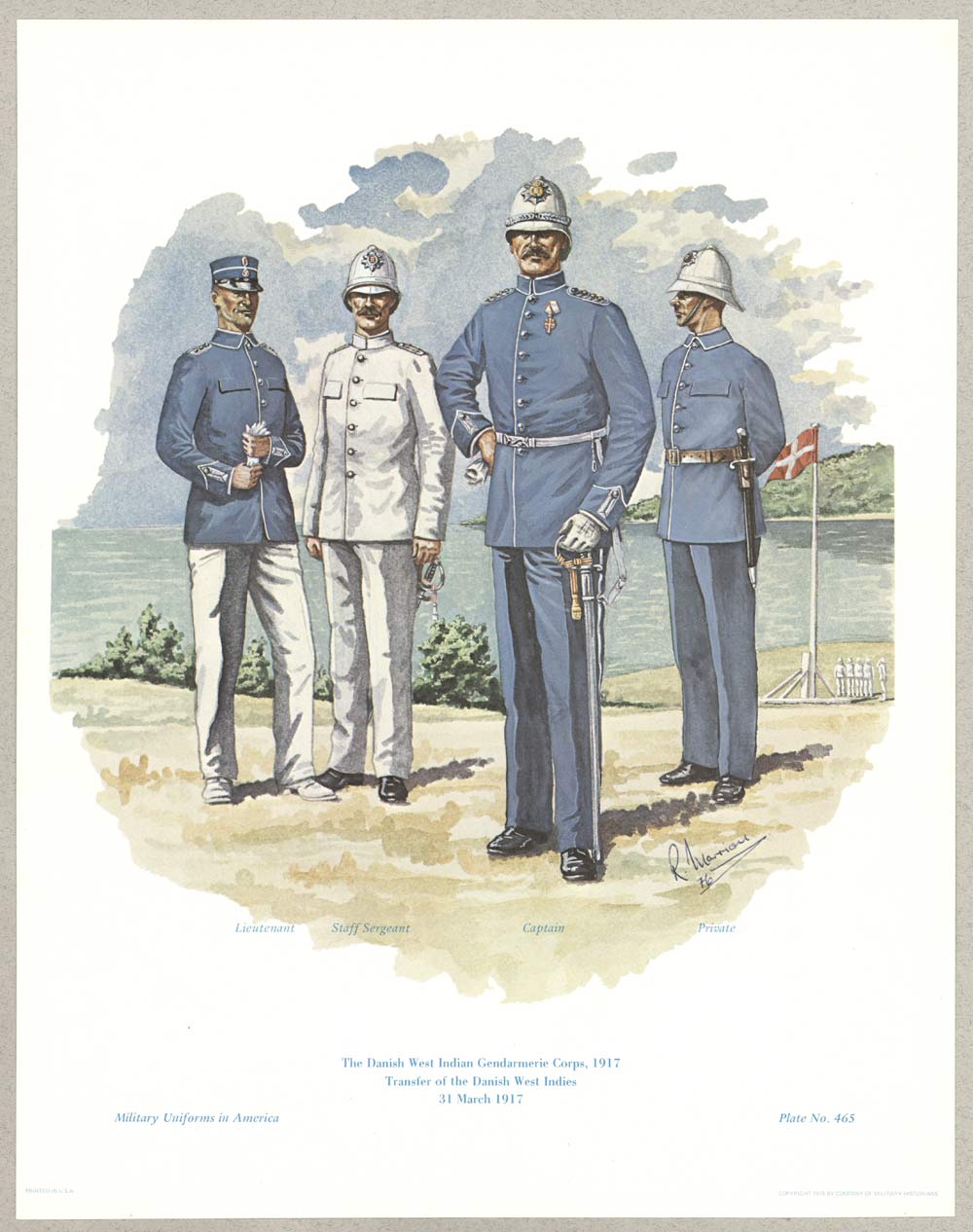
Today when people think of Danish colonies Greenland likely comes to mind, and that’s not exactly the sort of place where a sun helmet is often required. However, Denmark was a colonial power in tropical regions and while it never really competed with the British, French, Spanish or Dutch in the Caribbean, the first Danish colony was founded in the West Indies in the 1660s.
The Danish West India Company was organized on March 11, 1672 and soon after established a settlement on St. Thomas. The Danish West Indies were invaded twice by the British – the first time during the French Revolutionary Wars and the second time during the Napoleonic Wars. Following those bloodless invasions the islands were at relative peace and managed by the Danish West Indies Gendarmerie as well as the West Indian Military Forces.

A late 19th century period photo of a Danish West Indies Gendarmerie. Note the dark blue uniform and white trousers. The helmet, which seems similar in shape to the American M1887 sun helmet, features a plate on the front that is in the shape of a star with a shield and the Danish arms in the center.
According to the Danish archives for its former colony the number of military and paramilitary personnel never exceeded 100 men at any one time, but as noted there wasn’t much of a threat of invasion throughout the latter half of the 19th century or early 20th century.
Even during the brief Second Schleswig War, in which Denmark fought the Kingdom of Prussia and the Austrian Empire in 1864, there was little external threat to the islands.
The Danish West Indies Gendarmerie was outfitted with light blue or white uniforms, while the West Indian Military Forces reportedly wore a khaki uniform. The duties of these units likely overlapped and by the outbreak of the First World War – when Denmark maintained neutrality – it seems that for daily wear both units wore khaki, and blue or white for dress and ceremonial purposes.
The most interesting aspect of the largely forgotten Danish colonial forces is of course their sun helmets. Few if any seem to have survived even in museums, but this is likely due to the fact that the units were disbanded in 1917.
Based on photographic evidence the earliest helmets appear to be the typical “colonial pattern” and are possibly of British, French or American origins. A period illustration suggests that the helmets feature a six panel construction, which would support this theory.
However, given the close ties that the Danish maintained with the United States it is also possible that the helmets were American made – possibly Model 1887 helmets. Period photos show what is similar in shape to the American models.

This photo, which dates shortly before the handover of the Danish Virgin Islands to the United States, shows the West Indian Military Forces in khaki uniforms. The helmets appear to be similar in design to the Wolseley pattern – but could have been made in Spain.

This period illustration features a Danish West Indies Gendarmerie bandsman with what does appear to be a Wolseley helmet.
These “colonial” pattern helmets were worn with a helmet plate in the shape of a star with a shield and the Danish arms in the center. The same pattern plate was worn on the subsequent helmets, which based on period photographs were likely a British-made Wolseley or similar design, possibly a Spanish-made version.
Wolseley helmets were certainly used in the Caribbean from the beginning of the 20th century and remain in use today among the various police and paramilitary forces.
It should also be noted that the Danish West Indies Gendarmerie maintained control of the islands until January 1917, when according to the Treaty of the Danish West Indies, the Danish government sold the islands to the United States for $25 million.
The United States had been interested in the islands since at least the 1860s and finally acted in 1917 because of the islands’ strategic position near the approach to the Panama Canal and because of a fear that Germany might seize them to use as U-boat bases during World War I.
With the passing of the islands to the United States the Danish West Indies Gendarmerie as well as the West Indian Military Forces were each subsequently disbanded.
As noted, sadly no original helmets have are known as of this writing to exist.

A period color illustration highlighting the transfer of the Danish West Indies to the United States on March 31, 1917. Based on this print it seems that the Danish West Indies Gendarmerie were still wearing the colonial pattern helmet at this late date. This image suggests the helmets were of six panel construction, which could indicate that these were British or French in origin. However, as no actual helmet has materialized the origin of the helmets remains in question.
